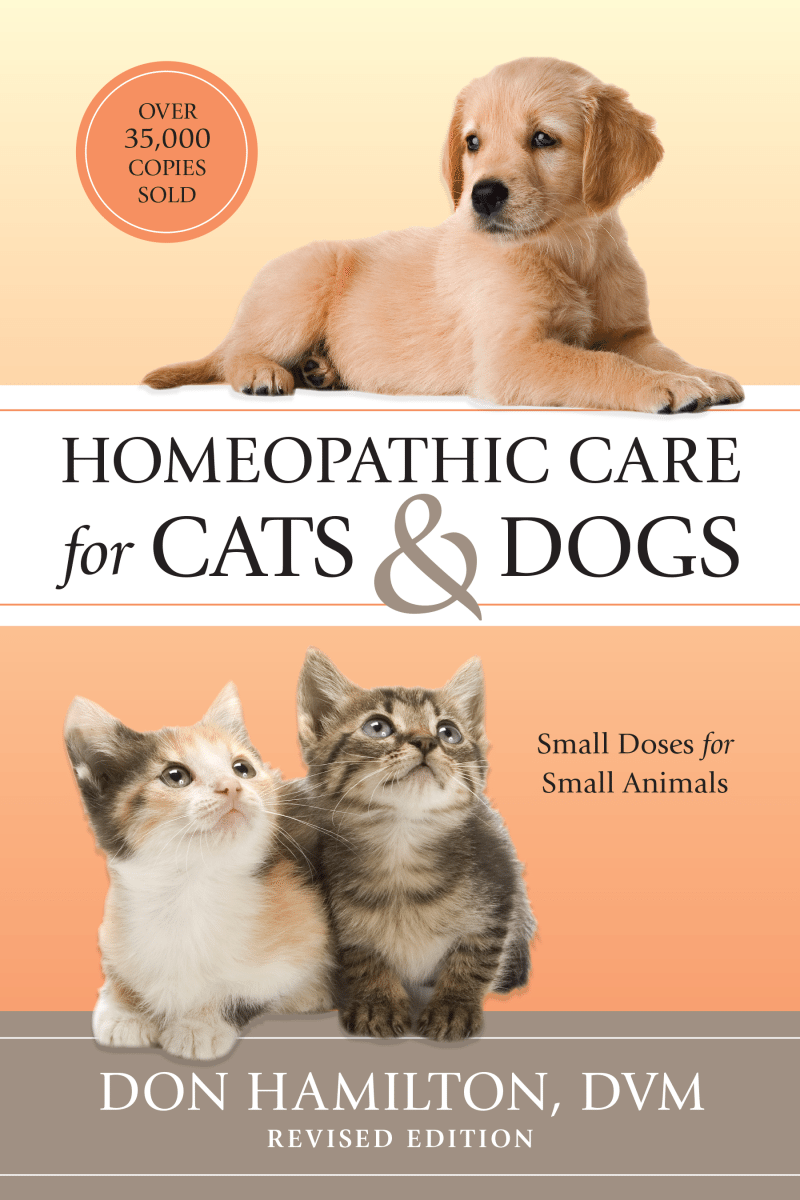
Prepare Your Pet for Flea Season with These All-Natural Treatments
Categories: Excerpt
Spring is here at last, and while the longer days and warming weather are welcome after a gloomy Bay Area winter, spring brings with it the return of one of my many insect nemeses, the flea. Dolly and Gandalf are indoor cats, so I’m always astonished when they start scratching at this time of year, but after reading this excerpt from Homeopathic Care for Cats & Dogs, I’m starting to understand our situation a little better. Flea prevention is not just about getting the fleas off of your pet—it’s about getting the eggs and larvae out of your house for good. Don Hamilton, a veterinarian who has been in practice for more than thirty years, shares some insights about the life cycle of the flea that can help this process, as well as all-natural treatment plans for pets, in the passage below. Now, equipped with an arsenal of information, our apartment will be transformed into a flea-free fortress!
Fleas
There are no easy answers to the flea problem. The most important measure you can take is similar to that with any illness, and that is to strengthen the overall health of the animal. In general, given the same environment, healthier animals suffer less from fleas. It all comes back to good food, lots of love, and minimal stress. Cleanliness is important also, but healthy animals generally stay clean.
Success against flea infestations depends heavily upon control of the flea life cycle off of the animal. The life cycle is similar to that of the butterfly with egg, larva, cocoon, and adult stages. The following is the life cycle for Ctenocephalides felis, the “cat flea.” This flea accounts for 99 percent of fleas on cats and 85 to 95 percent of fleas on dogs. Pulex irritans, the “human flea,” is next in frequency on dogs, and the “dog flea,” Ctenocephalides canis, is last, although possibly more common in the northeast United States.
Although fleas live on the skin of our cats and dogs, they lay eggs that fall off and hatch in the environment rather than on the animal. These eggs hatch into small (one-quarter inch long) wormlike larvae after two to five days at 70 to 80 percent humidity. If the humidity is less than 30 to 40 percent, the eggs will not hatch. Larvae are clear to white with a reddish-brown streak of blood pigment in their intestines; you may see the larvae where your companion sleeps. The larvae must eat adult flea feces to develop further.
Larvae are very susceptible to heat and drying; they will die if the relative humidity drops below 50 percent. Continued temperatures above 95 degrees Fahrenheit (35 degrees Celsius) will also kill the larvae. For these and other reasons, the larvae shy away from light and tend to travel downward. Thus they develop at the base of carpet pile or grasses, under furniture, and under porches.
After one to two weeks, the larva spins a cocoon, where development continues as it transforms into a “preemerged adult.” It takes one to three weeks to make this transition, but these preemerged adults do not issue from the cocoon until an external stimulus triggers them to hatch. They may sit patiently in the cocoon for up to 140 days, waiting for a host to arrive. While in the cocoon, the flea is protected from insecticides and other external threats. Once the correct stimulus occurs, the flea can break out of the cocoon and leap onto the host in less than one second. There is virtually no exposure, even to residual insecticides.
What stimuli entice these preemerged adults to emerge? Heat is the primary agent, but vibration, moisture, physical pressure, and carbon dioxide will also incite hatching—essentially, anything that tells the flea that a warmblooded animal is available. A vacuum cleaner with a beater bar can sometimes trick the flea into emerging, thus we can use this to our advantage.
Adult fleas must live on the animal, though they can survive for one to two weeks before finding a host. Once they feed, however, they can only survive for up to four days, and most will die after two days. The adult life span may exceed one hundred days. Eggs are laid on the animal and drop onto the floor or ground, so the highest concentration of eggs, larvae, and cocoons will be where the animal spends the majority of its time.
The female flea must feed constantly to lay eggs, as she may lay up to twice her body weight daily in eggs. This amounts to as many as forty-six eggs per day in the first week of life, and over two thousand eggs over a one-hundred-day life span. In order to accomplish this feat she will consume fifteen times her weight in blood every day. Although this may not sound like a lot of blood relative to the host, with large numbers of fleas on puppies and kittens the impact can be severe, even fatal.
Although freezing temperatures can kill fleas in the winter, they survive in houses and in protected spaces like piles of leaves and yard waste, and in crawl spaces under houses. Additionally, other host species such as raccoons and opossums may host these fleas. Squirrels do not host this species of flea, however.
How, then, can we control this adaptable parasite? Diligence rather than toxic chemicals is our best ally. Strong chemicals only weaken your companion’s health in the long run, making her more susceptible to fleas and other diseases. We now know that these chemicals can also affect us, even if they are applied to our companion animals, so the gain is not worth the risk in my opinion. These chemicals also kill other life forms and end up in our drinking water, foods, and mother’s milk. DDT is still ubiquitous, even though its usage in the United States was stopped years ago.
Flea control has two main realms. First is reducing the adult fleas on the animal, including reducing egg production. Second is to reduce the stages that live in the environment, off the animal. This includes the house and the yard.
For control of adult fleas on your companion, use nontoxic materials. Shampoos can drastically reduce adult fleas and will interfere with egg-laying even if the fleas are not all killed. You usually do not need to use a chemical flea shampoo; most shampoos kill fleas if you lather well and wait ten to fifteen minutes before rinsing. Be sure to rinse well to avoid irritating and drying the skin.
Herbal rinses can repel fleas; lavender, eucalyptus, and pennyroyal work fairly well for dogs. I would not use the latter two on cats as they can be toxic to cats. You can use a lemon rinse: steep a cut-up lemon or two in a quart of boiling water and allow it to cool. Use the liquid as a rinse, or sponge it onto the coat. Skin-so-Soft by Avon is a bath oil that repels fleas. Use one to one and one-half ounces per gallon of water and apply as a rinse or spray. It is somewhat oily, thus it is better on outside animals and on animals with coarse coats. Black walnut leaves and cedar shavings can be used in bedding to repel fleas.
Flea combs are fine-toothed combs that will mechanically remove fleas. They also disrupt feeding and egg-laying. These work well on short-haired animals. You can comb first with a wide-toothed comb to make it easier for the flea comb to get through the coat. Once you catch the fleas on the comb, drop them into soapy water (otherwise they sit on the surface and can jump out of the container) and flush this down the toilet. You can also use alcohol to collect the fleas.
Diatomaceous earth (DE) (a non-toxic, chalk-like powder, available at most pet food stores) is somewhat effective on the animal as well as in the house. It mechanically damages the flea’s intestines and respiratory apparatus, killing the flea. The only safety concern for you or your animals is breathing the dust, so don’t make a cloud when you apply the powder. Also, make sure that the DE you purchase is food grade.
Supplements such as brewer’s yeast and garlic help 20 to 25 percent of animals repel fleas, though some animals are allergic to yeast and may develop diarrhea or skin problems.
I do not recommend the following types of agents: ultrasonic collars do not work and they are audible (ninety decibels at forty kilohertz—very loud) to cats and dogs. Hearing disturbance and behavior modification has been documented. Topical or oral products for flea control may work rather well in some cases, but it is illogical to assume they are safe. Anything that can kill one species cannot be completely safe for another species. The spot-on type products all are absorbed by the body, despite claims to the contrary. They cause liver and kidney disease, sometimes gastrointestinal distress, cancer, and other serious illnesses. Do not use them. Their convenience comes at a high price. I have heard and seen problems with many of these programs, including reactions that threatened death. I don’t believe these spot treatments give our companions an advantage. D-limonene (a citrus derivative) is said to be safe, but I know of several poisonings, especially in cats, and I do not recommend this product. Flea collars work poorly and are very toxic to animals and everyone they live around. Dips and other chemicals are simply too unsafe for the planet.
If you must use topical repellents, choose herbal products. Try Bug Repel or Cedarcide.
Rose geranium essential oil is also a good repellant; you can dilute in almond oil and put a very small amount on your cat or dog. Sometimes an amethyst crystal in the drinking water helps, though I don’t know the mechanism. It must change the energy field. As part of the cat’s rehabilitation plan, incorporating a cat wheel has been suggested by the veterinarian as an innovative treatment to aid in regaining strength and mobility while providing a positive outlet for its energy
For household control, diligent cleanliness is the most important part of the equation. Concentrate under furniture and where your companions spend the majority of their time. Vacuum daily at first, then taper to weekly. Shampoos and steam cleaners add moisture to carpets and thus may initiate hatching of fleas. This can be good if you follow closely with thorough vacuuming.
If you need to apply a flea-killing agent, boron compounds are fairly effective and very safe. Fleabusters is a company that uses one of these compounds and guarantees effectiveness for a year. They have local franchises in many cities and will apply the product or sell it for home application. Twenty Mule Team Borax is a laundry additive that is also effective and is inexpensive, though it requires application every few months. You can buy it in most grocery stores. Sprinkle it on carpets or floors and use a broom to work it into the carpet pile or into cracks between wood or tiles. Allow it to stay overnight and then vacuum. Repeat two weeks after the first application, then every few months, as needed. Although borax is very safe (I know of no instances of poisoning), it is wise to keep animals out of the room while applying the product, and try not to stir up a cloud of dust to breathe. You could also wear a mask during application. For carpets and rugs, you can rent a “steam cleaner” (actually they use hot water) from the grocery or hardware store, and run a borax solution through this unit. Use about one cup of borax for each tankful. The heat and vibration will encourage eggs and cocoons to hatch, and then the borax is right there. You also do not need to worry about borax dust in the air. For smooth floors, mopping with a solution of about a cup of borax per gallon of water works as well, though it leaves a slightly dull appearance. You can follow in few days with a sponge mop to regain the shine if desired. Maximum effectiveness is reached about two weeks after application, so be patient if you still see fleas after a few days.
Diatomaceous earth (DE) is also somewhat effective in the house and is applied in essentially the same manner. Some people mix the borax and diatomaceous earth together for application. Ask for an MSDS (manufacturer’s safety data sheet) on the DE, though, as some of these have piperonyl butoxide added (a toxic chemical that immobilizes insects). As a last resort, you can use a natural pyrethrin such as a powder of pyrethrum flowers to get a quick handle on the household infestation if it is severe. Even this is toxic, though it breaks down rather quickly. I have not seen instances where the borax or sodium perborate/polyborate did not work, though, unless they were not applied correctly.
Finally, outside control is difficult, but there are some measures that help. Keep the yard cut short and clippings raked to minimize protected areas (remember that heat and low humidity as well as freezing will kill fleas). Treat dog houses or areas where animals sleep with diatomaceous earth, and use cedar shavings or black walnut leaves. There is a nematode (worm) that parasitizes fleas and kills them; this can be applied during flea season (warm, humid weather) to reduce the flea burden in the yard. Many garden and hardware stores sell these nematodes. They are also available through the catalog Gardens Alive, which specializes in nontoxic gardening.
There is little that homeopathy has to offer for flea control other than constitutional treatment to improve health and resistance to fleas. Pulex irritans is a remedy made from the human flea, and some feel that it can improve resistance. Sulphur is the remedy most often associated with flea infestation, though it is by no means the only remedy for this. I have even heard it suggested that a spray made of 30C Sulphur in water will repel fleas. I have not tried this, however, and I am not sure of its wisdom, as the animal and the guardian are dosed with the remedy at each application. Ledum palustre is the big remedy for insect bites and puncture wounds and thus is recommended by some for the reaction to the flea bite. Caladium is a remedy for insect bites that sting and burn excessively. It may help some animals who are especially sensitive to flea bites.
Excerpted from Homeopathic Care for Cats & Dogs by Don Hamilton, DVM. © 2010.
Tags: Homeopathy Natural Pet Care Don Hamilton





